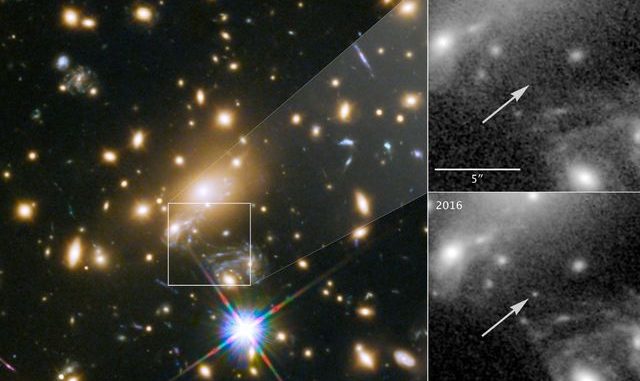
More than halfway across the universe, an enormous blue star nicknamed Icarus is the farthest individual star ever seen. Normally, it would be much too faint to view, even with the world’s largest telescopes. Through a quirk of nature that tremendously amplifies the star’s feeble glow, however, astronomers using NASA’s Hubble Space Telescope were able to pinpoint this faraway star.
The star, harbored in a very distant spiral galaxy, is so far away that its light has taken 9 billion years to reach Earth. It appears to us as it did when the universe was about 4 billion years old.
The cosmic quirk that makes this star visible is called “gravitational lensing,” first predicted by Albert Einstein. The effect is similar to that of an image behind a glass lens appearing distorted because of how the lens bends light. The discovery of Icarus through gravitational lensing has initiated a new way for astronomers to study individual stars in distant galaxies. These observations provide a rare, detailed look at how stars evolve, especially the most luminous stars.
How does gravitational lensing work? Gravity from a foreground, massive cluster of galaxies acts as a natural lens in space, bending and amplifying light. Sometimes light from a single background object appears as multiple images. The light can be highly magnified, making extremely faint and distant objects bright enough to see.
In the case of Icarus, a natural “magnifying glass” is created by a galaxy cluster called MACS J1149+2223. Located about 5 billion light-years from Earth, this massive cluster of galaxies sits between the Earth and the galaxy that contains the distant star. By combining the strength of this gravitational lens with Hubble’s exquisite resolution and sensitivity, astronomers can see and study Icarus.
“The star is so compact that it acts as a pinhole and provides a very sharp beam of light,” said Tommaso Treu, a professor of physics and astronomy in the UCLA College and a co-author of the research. “The beam shines through the foreground cluster of galaxies, which acts as a cosmic magnifying glass.”
The team dubbed the star Icarus after the Greek mythological character that flew too near the Sun on wings of feathers and wax that melted. Much like the mythological character, the background star had only fleeting glory as seen from Earth: It momentarily skyrocketed to 2,000 times its true brightness when temporarily magnified. Scientific models suggest that the tremendous brightening was probably from the gravitational amplification of a star, similar in mass to the Sun, in the foreground galaxy cluster when the star moved in front of Icarus.
“You can see individual galaxies out there, but this star is at least 100 times farther away than the next individual star we can study, except for supernova explosions,” said study leader Patrick Kelly of the University of Minnesota, Twin Cities.
When they analyzed the colors of the light coming from this object, they discovered it was a blue supergiant star. This type of star is much larger, more massive, hotter, and possibly hundreds of thousands of times intrinsically brighter than our Sun. But at this distance, it would still be too far away to see without the amplification of gravitational lensing, even for Hubble.


Be the first to comment